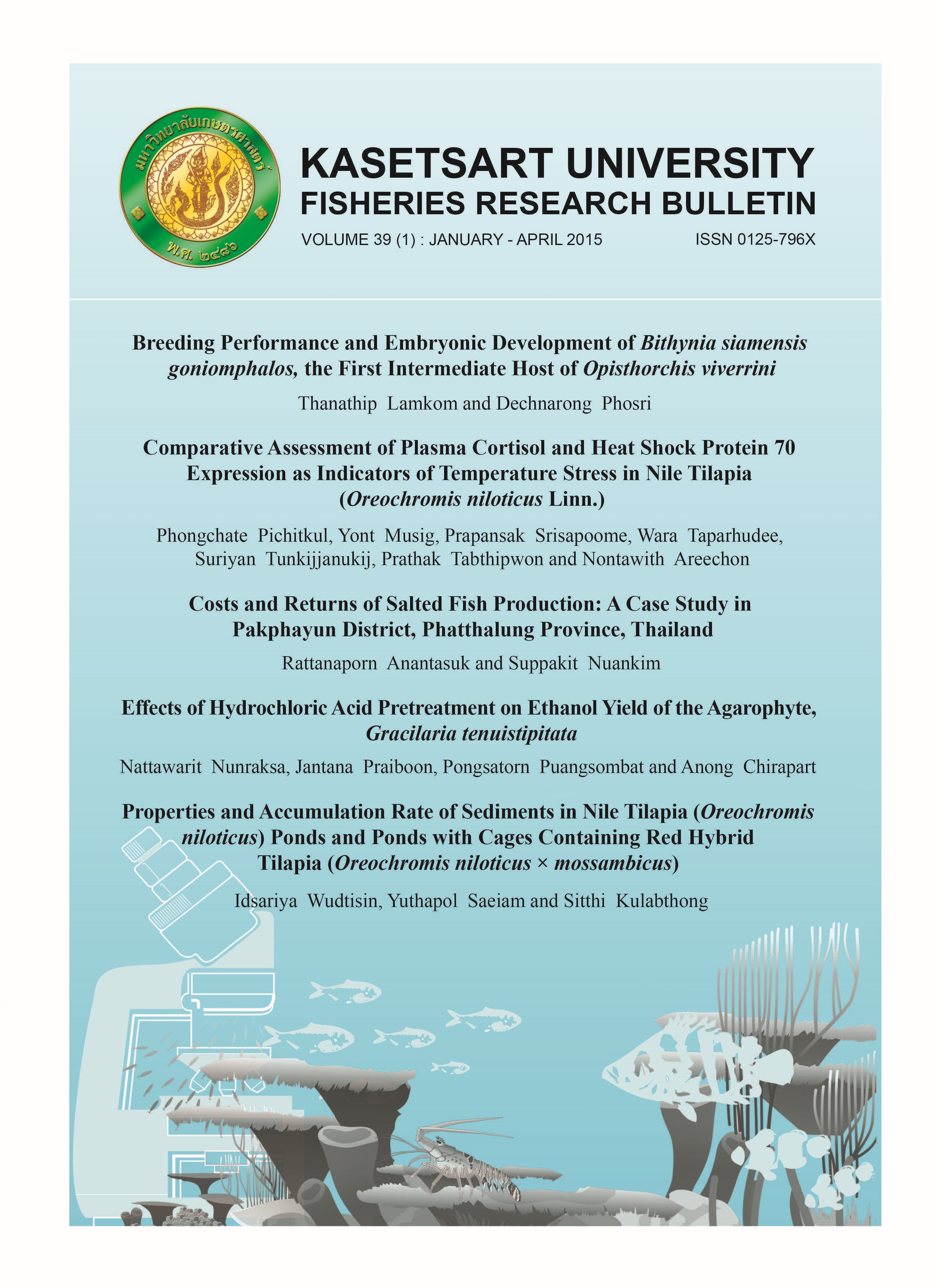Breeding Performance and Embryonic Development of Bithynia siamensis goniomphalos,the First Intermediate Host of Opisthorchis viverrini
Main Article Content
Abstract
The freshwater snail, Bithynia siamensis giomphalos, is the first intermediate host of liver fluke (Opisthorchis viverrini) in northeast Thailand. Wild broodstock of the snails from three dams, namely Nong Ham Dam (NH), Lampao Dam (LA), and Ubonrat Dam (UB) were collected and identified by sex. The male and female snails (2:3 sex ratio) were mated in a glass box (10x5x5.5 em) in three replicates. The average number of spawned eggs per day was highly significant in NH population (6.48-13.90 eggs) (P<0.05) compared with LA (4.57-9.22 eggs) and UB (2.70-5.63 eggs) populations. The hatching rate of B.s. goniomphalos larva for 30 days was 92.18, 90.94, and 93.07% in LA, NH, and UB populations, respectively. The hatching and survival rates of B. s. goniomphalos larva were similar among the three populations (P>0.05). The embryonic development composed of 5 stages, namely cleavage, morula, trochophora, veliger, and hippo stages. The breeding performance and embryonic development of snails may be essential for the control of 0. viverrini prevalence.
Article Details
References
2. Brandt, RAM. 1974. The non-marine aquatic Mollusca of Thailand. Archiv für Molluskenkunde 105: 1-423.
3. Brockelman, W.Y., E.S. Upatham, V. Viyanant, S. Ardsungnoen and R. Chantanawat. 1986. Field studies on the transmission of the human liver fluke, Opisthorchis viverrini, in northeast Thailand: population changes of the snail intermediate host. International Journal for Parasiology 16: 545-52.
4. Bureau of Epidemiology. 2006. Reported the surveillance of liver fluke. National Notifiable Disease Surveillance (Report 506). Department of Disease Control, Ministry of Public Health, Thailand.
5. Chitramvong, Y.P. 1992. The bithyniidae (gastropoda: prosobranchia) of Thailand: comparative external morphology. Malacological Review 25: 21-38.
6. Dillen, L., K. Jordaens, L.D. Bruyn and T. Backeljau. 2010. Fecundity in the hermaphroditic land snail, Succinea putris (Pulmonata: Succineidae): Does Body size matter? Journal of Molluscan Studies 76: 376-383.
7. Forbes, V.E. and G.R. Lopez. 1990. The role of sediment type in growth and fecundity of mud snails (Hydrobiidae). Oecologia 83: 53-61.
8. Gomot, A. 1998. Toxic effects of cadmium on reproduction, development, and hatching in the freshwater snail, Lymnaea stagnalis for water quality monitoring. Ecotoxicology and Ecotoxicology and Environmental Safety 41(3): 288-297.
9. Grundy-Warr, C., R.H. Andrews, P. Sithithaworn, T.N. Petney, B. Sripa, L. Laithavewat and A.D. Ziegler. 2012. Raw attitudes, wetland cultures, life-cycles: Socio-cultural dynamics relating to Opisthorchis viverrini in the Mekong Basin. Parasitology International 6: 65-70.
10. Kaewphan, S. 1982. Effect of water temperature and calcium cabonate on growth, reproduction and survialship of the snail, Bithynia siamensis goniomphalos. M.S. Mahidol University.
11. Kaewpitoon, N., S.J. Kaewpitoon and P. Pengsaa. 2008. Opisthorchis in Thailand: Review and current status. World Journal of Gastroenterology 14(15): 2297-2302.
12. Kiatsopit., N., P. Sithithaworn, W. Saijuntha, T. Boonmars, S. Tesana, J. Sithithaworn, T.N. Petney and R.H. Andrews. 2012. Exceptionally high prevalence of infection of Bithynia siamensis goniomphalos with Opisthorchis viverrini cercariae in different wetlands in Thailand and Lao PDR. The American Journal of Tropical Medicine and Hygiene 86(3): 464-469.
13. Kiatsopit, N., P. Sithithaworn, W. Saijuntha, T.N. Petney and R.H. Andrews. 2013. Opisthorchis viverrini: Implications of the systematics of first intermediate hosts, Bithynia snail species in Thailand and Lao PDR. Infection Genetics and Evolution 14: 313-319.
14. Kruatrachue, M., Y.P. Chitramvong, E.S. Upatham, S. Vichaisri and V. Viyanant. 1982. Effects of physico-chemical factors on the infection of hamsters by metacercariae of Opisthorchis viverrini. Southeast Asian Tropical Medicine and Public Health 13: 614-617.
15. Lalah, J.O., G.F. Severin, K.W. Schramm, D. Lenoir, A. Behechti and K. Guenther. 2007. Effects of a branched pnonylphenol isomer (4(3',6'-dimethyl- 3'-heptyl)-phenol) on embryogenesis in Lymnaea stagnalis L. Archives of Environmental Contamination and Toxicology 52(1): 104-112.
16. Lohachit. 2004-2005. Ecological studies of Bithynia siamensis goniomphalos, a snail intermediate host of Opisthorchis viverrini, in Khon Kaen province, northeast Thailand. Malacological Review 37(38): 1-26
17. Ngern-klun, R., K. Sukotason, S. Tesana, D. Sripakdee, K.N. Irvine, K. Sukontason. 2006. Field investigation of Bithynia funiculata intermediate host of Opisthorchis viverrini in northern Thailand. The Southeast Asian Journal of Tropical Medicine and Public Health 37: 662--672.
18. Norton, C.G. and J.M. Bronson. 2006. The relationship of body size and growth to egg production in the hermaphroditic freshwater snail, Helisoma trivolvis. Journal of Molluscan Studies 72: 143-147.
19. Petney, T., P. Sithithaworn, R. Andrews, N. Kiatsopit, S. Tesana, C. Grundy-Warr and A. Ziegler. 2012. The ecology of the Bithynia first intermediate hosts of Opisthorchis viverrini. Parasitology International 61: 38-45.
20. R Development Core Team R. 2006. R: a language and environment for statistical computing (https://www. R-project.org). Vienna, Austria: R Foundation for Statistical Computing.
21. Singkachart, S. 1989. Preliminary study on life table and some biological attributes of Bithynia siamensis goniomphalos Morelet. Master of science (Zoology) Kasetsart University. 82 p.
22. Sitthithaworn, P., R.H. Andrews, N.V. De, T. Wongaroj, M. Sinuon, P. Odermatt, Y. Nawa, S. Liang, P.J. Brindley and B. Sripa. 2012. The current status of opisthorchis and clonorchiasis in the Mekong Basin. Parasitology International 61: 10-16.
23. Sripa, B., J.M. Bethony, P. Sithithaworn, S. Kaewkes, E. Mairiang, A. Loukas, J. Mulvenna, T. Laha, P.J. Hotez and P.J. Brindley. 2011. Opisthorchis and Opisthorchis-associated cholangiocarcinoma in Thailand and Laos. Acta Tropica 120S: S158- S168.
24. Suwannatrai, A., K. Suwannatrai, S. Haruay, S. Piratee, C. Thammasiri, P. Khampoosa, J. Kulsantiwond, S. Prasopdee, P. Tarbsripair, R. Suwanwerakamtorn, S. Sukchan, T. Boonmars, J.B. Malone, M.T. Kearney and S. Tesana. 2011. Effect of soil surface salt on the density and distribution of the snail Bithynia siamensis goniomphalos in northeast Thailand. Geospatial Health 5(2): 183-190.
25. Waikagul, J. 1998. Opisthorchis viverrini metacercaria in Thai freshwater fish. The Southeast Asian Journal of Tropical Medicine and Public Health 13: 138-141.
26. Wang, Y.-C., R.C.Y. Ho, C.-C. Feng and J. Namsanor. 2015. An ecological study of Bithynia snails, the first intermediate host of Opisthorchis viverrini in northeast Thailand. Acta Tropica 141: 244-252.

